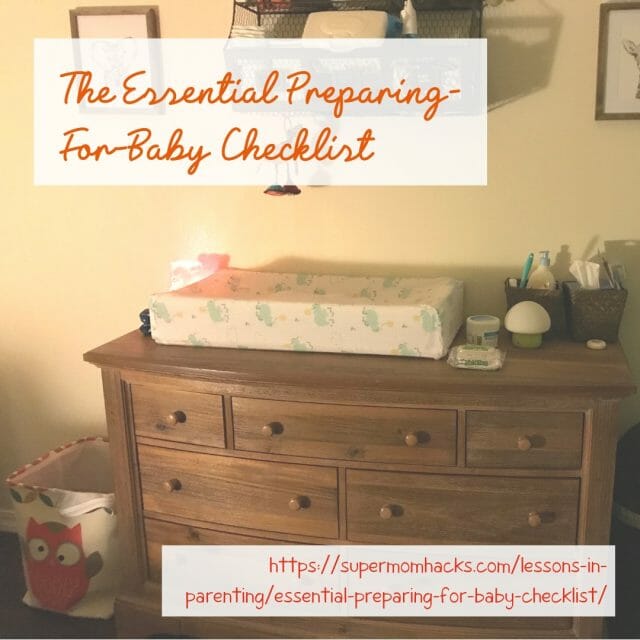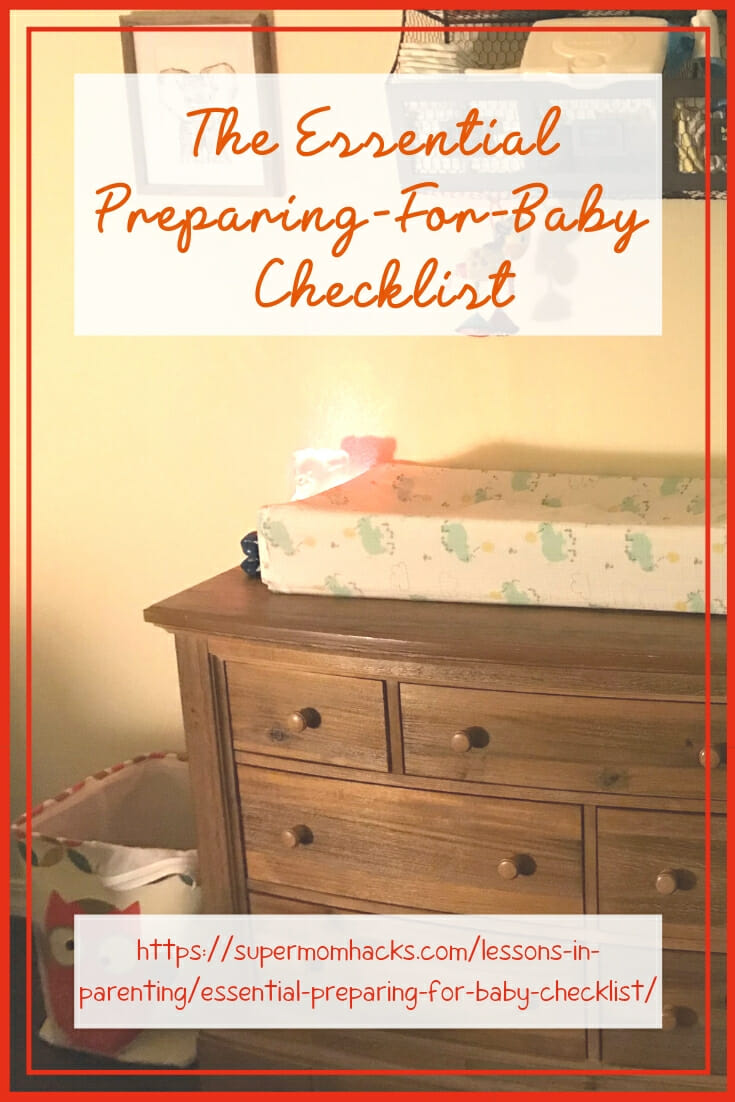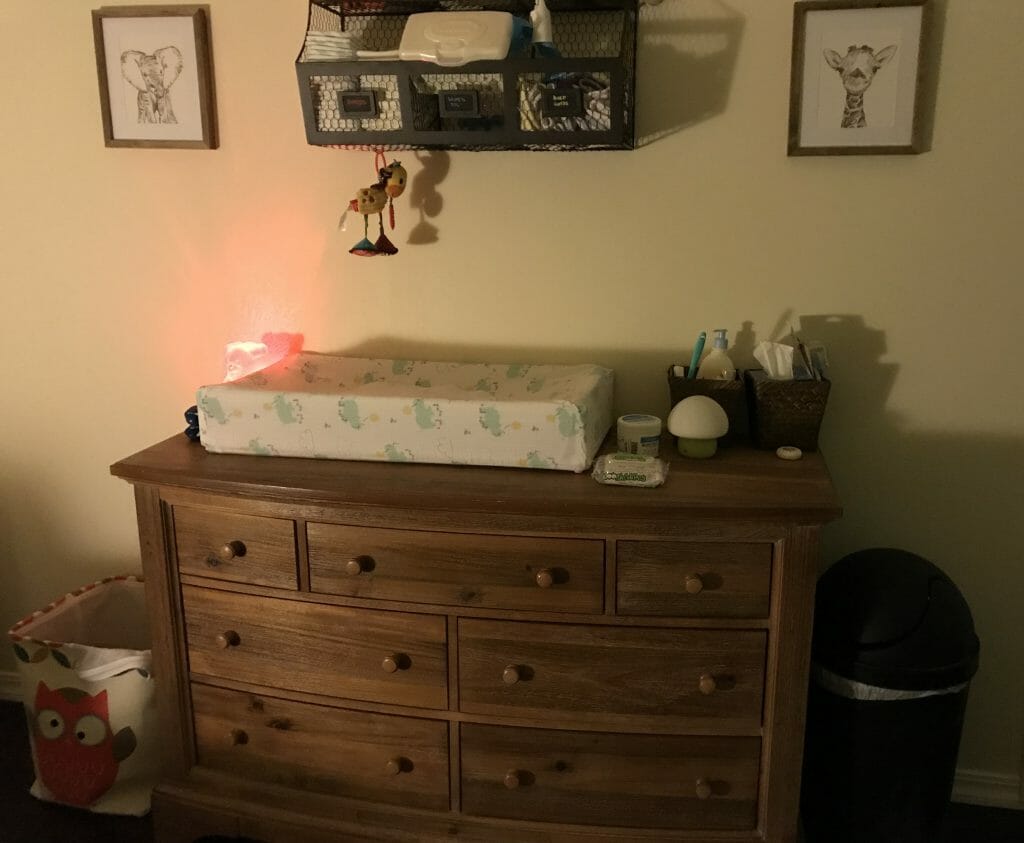Must-Haves When Expecting A Baby
Congrats, expecting parents-to-be! All set for your baby (or babies) to arrive? Not sure? No worries – this essential preparing-for-baby checklist has you covered, with everything you’ll need to stock up on before your little one arrives.
Preparing for your baby emotionally is tough enough, let alone wrapping your brain around all. the. STUFF. that babies need! (Who would have thought that someone so little could come with so much gear???) Hence this checklist. Are you ready? Let’s get started!

This is a collaboration post. However, please know I stand behind everything written here, and only include links to products/services/resources I’m willing to recommend personally.
Your Essential Preparing For Baby Checklist
1. Baby’s Space
Whether this is a full-blown nursery, or just a corner of the master bedroom for now, Baby really doesn’t need a TON. In fact, Baby’s needs are pretty basic – and for starters, pretty minimal.
RELATED POST: What Your Baby Really Needs In The Nursery
RELATED POST: Designing Your Nursery On An Budget
The froofy extras, like custom wall art and fancy pillows galore, are nice – but not essential, especially not at first. Your money will be better spent on a decent rocking chair, a dresser that will hold Baby’s clothes and beyond, and a changing surface (which could be a pad secured to the top of the dresser).
Also figure out where Baby will sleep for at least the first several years, both at night and during the day. Planning to get a crib for Baby? A convertible crib is a good idea IF you’re a one-and-done family. Otherwise, consider just a basic crib vs. one that converts to a regular bed, especially if this will save you money. You can always snag a bed frame/mattress set down the road. (Our girls’ beds are both antiques that we got secondhand and then refinished.)
But Baby will also need napping spots throughout the house. A bassinet is portable, but Baby will outgrow it sooner than a small play yard. (The Cosco Funsport is an inexpensive, bare-bones model that we loved because – unlike most play yards – it was narrow enough to move through our home’s doorways without disassembling.)
And if space or money is tight, skip the crib altogether; just go for the Cosco Funsport until Baby is big enough for a toddler bed. You’ll save a ton of room AND money. Instead, invest in one or more rocking chairs for around the house. A glider-rocker with ottoman is a splurge that I still love, and the girls love curling up in ours to read.
RELATED POST: Baby In A Small Space: Five Hacks To Save Room (And Money!)
2. Baby’s Wardrobe
For starters, your baby is going to require a lot of clothes:
- sleepsacks (which are like wearable sleeping bags – heavy fleecy ones for winter babies, lightweight muslin ones for summer babies);
- sleep-n-plays (these are the things that look like miniature footed PJs);
- onesies/bodysuits (the things like shirts that snap shut in the crotch) – both long-sleeve and short-sleeve;
- hats and socks/booties, especially for winter babies;
- several decent outfits for outings and company (you don’t need to go overboard here);
- a full-body snow suit or similar winter-warm gear for babies in cold winter climates;
- and short-sleeve or sleeveless rompers/romper-style dresses for summertime babies.
How many of each you’ll need depends in part on whether you have a washer/dryer at home or not. (If you do, you’ll probably be washing at least one load per day for a newborn, so you can get away with slightly fewer clothes.)
DON’T overbuy on the smaller sizes, or buy all sizes all at once. Stocking up on a 6-9 months snowsuit isn’t the brightest idea for your fall-born baby, unless you live somewhere where it’s cold and snowy in the middle of summer.
3. Baby’s Gear
There are so many types of gear babies need around the house. But maybe not everything you think they need.
For starters, skip the crib bumpers, crib quilts, fancy pillows, stuffed animals, etc. Until Baby is at least one, the risk of SIDS means these should be nowhere near your sleeping child. Baby would be better off with a white-noise machine (here is our fave), and/or a nighttime buddy like GroFriends, such as Henry the Hedgehog. (Just remember that the stuffed-animal comfort items need to stay OUTSIDE the crib while Baby is sleeping!)
A mobile with a music box on a timer is also a good investment. You’ll need to disassemble the mobile by the time Baby is 5 months, but you can use the detachable music box as a sleep-time cue for years to come. (Essie used to love turning on the music for herself to listen to when she awoke in the morning.)
You’ll also want a separate infant tub for at least the first six months. These are inexpensive and you don’t need a fancy one, but until Baby is big enough to sit up, this will be much easier/safer than bathing in a full-sized tub or a sink.
And while you’ll want to have some diapers and wipes on hand, don’t go overboard on the smaller sizes here, either. Baby might well have outgrown the newborn size by the time s/he comes home from the hospital.
Finally, you don’t need a ton of toys to start, either. There are plenty of different soft toys to choose from, and a rotating assortment is good for play at home, entertainment in the car, and amusement when on outings. But there’s no need to buy out the store.
4. Baby’s Feeding
Now that insurance covers breast pumps, it’s worth considering getting a double-electric pump before Baby arrives, even if you don’t expect to return to work. (I needed one because of Kimmie’s early feeding problems.) Having the option of Daddy feeding Baby a bottle of pumped milk so Mama can nap is SO helpful!
This means you’ll also need some bottles, even if you don’t plan to formula-feed. At least 3 for starters is good (we just used free samples from baby registries). Likewise, snagging a few free formula samples while you’re pregnant will come in handy should you find yourselves, as we did, with a baby who’s not getting enough to eat at the breast. Formula is expensive!!! And you can always donate the samples you don’t use to a women’s shelter.
Besides this, think about what things will make you and Baby most comfortable during feeding time. I highly recommend some soft lights in the nursery, as well as the previously-mentioned rocking chair. A Boppy or similar nursing pillow is super-helpful for positioning Baby, even if you’re bottle-feeding. A low footstool or nursing stool will make Mama more comfortable. And plenty of burp cloths (plus perhaps a spare outfit for Parent if you’re out in public) is a good idea, too. Babies spit up a lot!
5. Baby’s Travel Needs
Preparing for Baby to get out on the town is also a must-do-before-Delivery-Day. (If nothing else, Baby will need lots of doctor’s appointments in that first year.)
Think carefully about your options when selecting a car seat; there’s a lot to consider. You might check out https://babyseats.reviews/10-best-selling-child-car-seats-under-200-dollars for ideas on car seats that won’t break the bank. When choosing a car seat, these are some of the things to consider:
- How long will it hold Baby? How long rear-facing? With the nationwide push in the U.S. toward keeping children rear-facing until age 2, you’ll want one that can accommodate this.
- While convertible car seats that hold Baby from 0-5 years or beyond may seem like a huge cost savings, keep in mind that you can’t easily remove these car seats. If you live where it gets hot or cold, you’ll be better off with a seat that detaches from its base, so you can carry it into the house or clip it onto your stroller/stroller frame. It’s much nicer to strap Baby in while in a climate-controlled setting, vs. in the freezing cold or hot summer sun.
- Check out safety ratings (we used our online Consumer Reports subscription for this) before you buy. But also consider ratings such as “ease of installation.” And get an experienced parent over to help you install the seat (or get your installation checked by the local police) long before your due date.
- Speaking of which – when you choose the perfect stroller, keep in mind that getting an all-in-one travel system (stroller + car seat) can save you a bundle. Plus they’re super-convenient. (Also remember that fancy strollers like joggers usually aren’t recommended for infants under age 1 – too much jostling. And they don’t fold up very compactly, either.)
6. Baby’s Health
And speaking of doctor’s appointments: the last thing you want to neglect when preparing for Baby is Baby’s future health and wellness. This means planning ahead for Baby’s health care needs.
Try to line up your doctor for Baby BEFORE Baby arrives. If you have a family history with a general practice, you may consider just going there. But if you have a good pediatric practice in your area, or several to choose from, I’d recommend that route instead. In our experience, pediatric practices are your best bet for staying on top of required vaccinations and immunizations. They’re also used to handling the various physicals and forms required for school, sports, etc. at each stage of the game.
RELATED POST: Choosing Your Child’s Doctor
Most pediatricians’ offices will be happy to set up “prospective new patient consult” appointments for free, usually either right before lunch or right at the end of their day. When we interviewed several practices this way, it was clear to us which was most in line with what we were looking for. Even if all goes well with the birth process, your child will need a ton of “well-baby checks” in the first year of life – even more if there are any complications with (for example) feeding.
Assuming you have private insurance through your employer or your spouse’s, you’ll need to make sure to get your new family member enrolled in your insurance ASAP. The only exceptions to open enrollment laws in the U.S. generally occur with a “change in family status” – marriage, divorce, death, or birth.
Therefore, you’ll probably need to enroll Baby within that first month after birth. Check with a Human Resources benefits manager at your work (or your spouse’s), to see if you’ll need an appointment, and what forms you’ll need to complete. At the very least, you’ll need to bring a copy of Baby’s birth certificate, and possibly also their Social Security card.
The bottom line:
There is so much to take care of when you’re preparing for Baby to join your family. It’s my hope that the tips in this checklist will go a long way towards helping you to get ready for your newest family member.
If you enjoyed this essential preparing-for-baby checklist, why not share it with others by pinning this image?

NOTE: This site contains affiliate links. I may earn a small commission from any purchases made through affiliate links, at no additional cost to you. For more information, please read the full disclosure/privacy policy.

